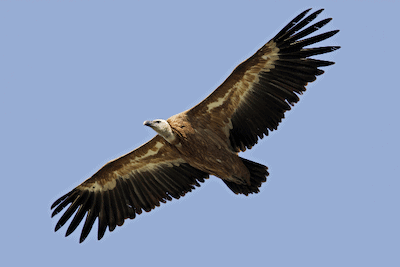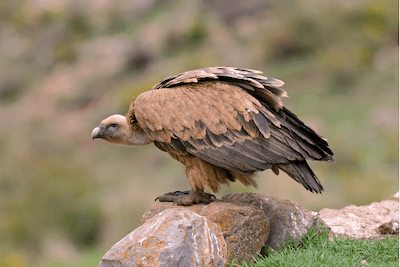Eurasian Griffon Vulture
(Gyps fulvus)
The Eurasian Griffon Vulture (also known as the European Griffon) is one of the largest birds of prey in Europe, almost equaling the Cinereous Vulture in size.

A very successful reintroduction effort with Eurasian Griffon Vultures in central France has resulted in a dramatic population increase in this region, which is a very hopeful sign for the future of this species.
However, in order to ensure the survival of the European Griffon Vulture, it is essential to make sure that its main food source, animal carcasses, are not removed from the landscape.
Fortunately, in recent years, some European countries have changed their legislation allowing farmers to leave dead livestock out in the open, but this needs to continue in other countries to improve conditions for European Griffons.
Eurasian Griffon Vulture facts
The Eurasian Griffon Vulture is a huge vulture species that is most often found soaring in the sky, or congregating around carrion together with other vultures, where it is one of the dominant vulture species.
Eurasian Griffon Vulture size
The European Griffon Vulture is a very large vulture species. It is often found feeding together with other vultures at animal carcasses.
- Wingspan: 238-280 cm
- Length: 95-107 cm
- Weight: 6,150-11,000 g
While similar in size to Cinereous Vultures, it’s relatively easy to tell the two species apart because Cinereous Vultures are much darker (almost black, in fact) than Euroasian Griffon Vultures.
Appearance
As a very large vulture, these raptors have very long, broad wings that makes them easy to spot when they soar high over the landscape while looking for food. When they congregate on a dead animal, they are easy to tell from other European vulture species due to their naked head and neck.

Sexual dimorphism
Unlike other European raptor species, female Eurasian Griffon Vultures are not larger than males, and the two sexes closely resemble each other.
Lifespan
With a maximum age of 55 years recorded in captivity, the Eurasian Griffon Vulture has the longest lifespan of all European raptors.
Scientific name and taxonomy
The scientific name of the Eurasian Griffon Vulture is Gyps fulvus. It is thought that there are two subspecies, only one of which occurs in Europe.
Eurasian Griffon Vulture distribution
In Europe the Eurasian Griffon Vulture is found mostly in countries that border the Mediterranean sea, though there has recently been an increase in sightings of these raptors in central parts of Europe. Outside of Europe, its range extends eastwards through Turkey and Arabia to Central Asia.
Eurasian Griffon Vulture habitat
The main requirements it has of its habitat is the availability of cliffs for nesting, and plentiful medium-sized or large animals that become available as carrion regularly. It also prefers landscapes with hills or mountains, as these support the formation of thermal currents, which is uses for soaring and foraging.
Eurasian Griffon Vulture population size
The Eurasian Griffon Vulture is the most common vulture species in Europe, with a total population that is estimated to be about 26,000 pairs, of which the majority (25,000) breed in Spain. Outside of Spain, most local populations are very small, although the French population has shown a very impressive population growth, and now numbers more than 800 pairs.
Eurasian Griffon Vulture behavior
The European Griffon Vulture spends a lot of time soaring on thermal currents while scanning the landscape below for dead animals. Using thermals allows it to cover large distances while conserving energy.
Griffon Vultures often live together in colonies, and also benefit from each other while foraging for food. When one vulture stoops down after spotting an animal carcass, this alerts all other vultures for miles around, which follow the first one to the carcass.
Feeding and diet
Feeds almost exclusively on carrion of medium to large sized animals. In previous centuries, it benefited from livestock carcasses in addition to wild animals, but due to regulations forcing farmers to destroy the remains of dead livestock, this food source has become scarcer for Eurasian Griffon Vultures.
Breeding
Nests are predominantly built in cliffs, though in rare cases it will use nests built by Cinereous Vultures in trees. The female lays only 1 egg, which is incubated for up to 58 days. After hatching the chick spends 115 to 160 days in the nest, and continues to be fed by its parents after fledging.
Migration
While adults are mostly sedentary and stay close to their breeding grounds all year long, juveniles are nomadic, and disperse over large distances. Juvenile birds move predominantly in a southern direction, and cross the Mediterranean at Gibraltar together with other migratory birds.
Eurasian Griffon Vulture conservation status
The overall European population of the Eurasian Griffon Vulture is stable, and even growing in some areas (such as central France), which is why it’s classified as “Least Concern” by BirdLife International.
However, the largest part of the European Griffon Vulture population is based in Spain, and f you look outside of its core distribution range on the Iberian peninsula, most other populations are small and disjointed, which makes them much more vulnerable to persecution or other adverse events.
The Eurasian Griffon Vulture in central France has grown dramatically over the past decades, as a result of sustained protection as well as reintroduction efforts. This shows that this vulture species can be readily restored to many parts of its former range if we apply ourselves to this task.
Threats
Due to its preference for carrion, the main threat to European Griffons is illegal poisoning from poisoned baits.
While poisoning is usually not directly targeted at this species, it is often the first species to suffer from it. In addition to poisoning, the removal of dead livestock deprives the Eurasian Griffon Vulture of its most important food source in many locations.
